Understanding Surfing Flotation Vests: Safety and Style
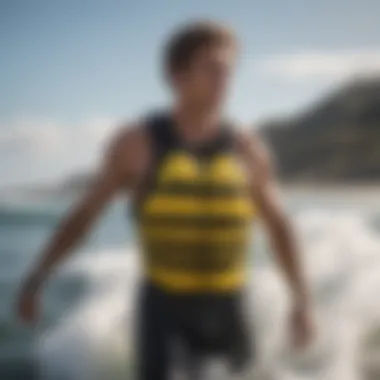

Intro
In the vast oceanic expanse, where waves crash and the thrill of riding swells beckons, surfing flotation vests emerge as not just an accessory, but a pivotal companion for surfers of all levels. As the surf culture evolves, understanding the design and functionality of these vests becomes increasingly essential. The right flotation vest can transform a ride — offering safety, enhancing performance, and connecting us to a rich cultural narrative.
This article ventures into the heart of flotation vests, dissecting their components, discussing their impact on safety and performance, and navigating through their environmental implications. In a sport where conditions can change in a blink, having the right flotation gear is akin to having a lifeline; it’s not just about staying afloat but also enjoying the thrill of the ride without unnecessary worries.
Let’s start by uncovering the nuances of surfboarding techniques that can be enhanced by the safety provided through flotation vests.
Understanding the Necessity of Surfing Flotation Vests
When it comes to surfing, the thrill can be matched only by the unpredictability of the ocean. That's where the significance of flotation vests steps in. Far more than just any piece of gear, these vests serve a dual purpose: they protect and enhance. As surfers immerse themselves in roaring waves, the addition of flotation vests becomes not merely an option, but a necessity.
Safety First: The Role of Flotation Vests
Safety is paramount in any sport, and surfing is no exception. When riders venture out into the surf, they face risks, such as sudden rip currents or unanticipated wipeouts. The role of flotation vests is to provide buoyancy, allowing surfers to maintain their heads above water, even in turbulent conditions. This feature is particularly crucial for those who might struggle with swimming or need a little extra support.
- Enhanced Visibility: Many vests come in bright colors or reflective materials, making surfers easier to spot in choppy waters, which can be a lifesaver, especially in crowded beaches.
- Impact Protection: Beyond buoyancy, flotation vests also offer a layer of protection against body impacts during falls or collisions with a board or another surfer.
"A flotation vest is like a seatbelt for surfers; it’s not about how fast you can go, but how safe you can be while surfin’ those waves."
The Evolution of Flotation Technology in Surfing
Flotation technology has come a long way from its rudimentary beginnings. In the early days, life jackets were bulky and awkward, offering limited mobility. Today, advancements have transformed the landscape. Materials like neoprene and advanced foams make vests not just safer but also more comfortable, aiding in unrestricted movement necessary for maneuvering on a board.
- From Bulky to Streamlined: The evolution of design focused on reducing the bulk while enhancing buoyancy. Newer models utilize lightweight materials that conform to the body, providing support without weighing the surfer down.
- Smart Innovations: Brands are integrating features like quick-drying fabrics and adjustable straps for optimal fit. Some even include integrated pockets for essentials like keys or small tools.
The past few decades have witnessed a shift in attitude towards safety gear, moving from optional to essential. Surfing culture is increasingly recognizing that while riding the waves is exhilarating, promoting safety through flotation vests amplifies one's ability to enjoy the surf, ensuring surfers return to shore – time and again.
Key Features of High-Quality Flotation Vests
When it comes to surfing, flotation vests are more than just an accessory; they are a critical component that can significantly impact both safety and performance on the waves. Selecting a high-quality vest can set a surfer apart, not just in style but in functionality as well. Understanding the specific features that define a quality flotation vest is essential for anyone keen on maximizing their surfing experience.
Materials and Their Importance
The materials used in flotation vests directly affect durability, comfort, and buoyancy. Generally, high-end vests incorporate neoprene and high-density foam, both known for their resilience and effectiveness in providing flotation. Neoprene serves as a flexible yet sturdy fabric that stretches with the movements of the surfer without feeling restrictive. It also helps in retaining body heat, useful on chilly morning surf sessions.
High-density foam is another game changer. This type of foam is lightweight yet buoyant, allowing surfers to enjoy their ride without excessive bulk. The combination of these materials not only enhances safety by ensuring that the vest will keep a surfer afloat but also promotes ease of movement, crucial when catching a wave. Comfort should never be overlooked; a vest that fits poorly can hinder performance more than it helps.
"A flotation vest made with subpar materials won’t just be uncomfortable, it can also become a liability on the water."
Ergonomic Design: Comfort Meets Functionality
Ergonomics in design plays a huge role in how a vest interacts with a surfer's body. Vests should ideally contour to the natural shape of the body, preventing excess chafing and discomfort during long hours on the water. Features like adjustable straps and side panels can often make or break the fit. An adjustable vest allows for better customization, which is important as body shapes and sizes vary widely.
Additionally, venting is emerging as a feature of modern flotation vests. Breathable panels and drainage holes are critical for maintaining comfort, especially during long paddle-outs. If a vest retains water, it becomes heavy and can impede movement. An ergonomic vest not only promotes freedom but can also enhance performance by allowing quick transitions between paddling, riding, and breaking.
Buoyancy Levels: Understanding Your Needs
Exploring buoyancy levels is crucial in choosing the right flotation vest. The ideal level of buoyancy largely depends on the surfer's skill level and the conditions they usually face. For instance, beginners or those surfing in turbulent waters may benefit from higher buoyancy for extra support. In contrast, seasoned surfers aiming for high performance might prefer lower buoyancy, which allows for a more natural freedom of movement.
Different manufacturers rate their vests with varying buoyancy levels, usually measured in pounds of flotation. Understand how these ratings correlate to your capabilities and your surfing environment. A thoughtful approach to buoyancy can mean the difference between a thrilling ride and a troublesome tumble.
To summarize this section:
- Materials: Quality and suitability matter; choose neoprene and high-density foam.
- Ergonomic Design: Prioritize comfort with adjustable features and good ventilation.
- Buoyancy Levels: Consider your skill level and typical surfing conditions for well-rounded performance.
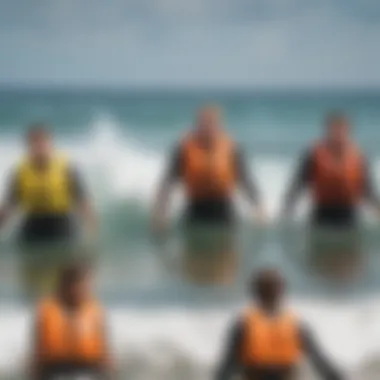
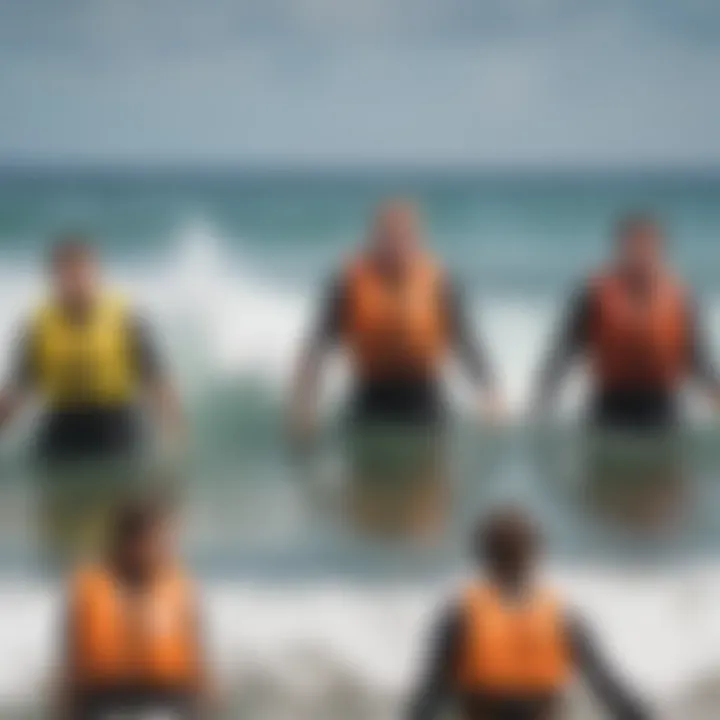
Investing in a high-quality flotation vest with these features can profoundly influence not only safety but overall enjoyment while surfing. Understanding these traits aids surfers in making informed decisions that align with their personal needs and surfing ambitions.
Types of Flotation Vests Suitable for Surfing
When it comes to surfing, flotation vests are not just about buoyancy; they play a critical role in ensuring a safe and enjoyable experience on the waves. Selecting the right vest is crucial, as not all vests are created equal. Each type serves varied purposes, catering to different surf styles, conditions, and even personal preferences. From comfort and mobility to specific safety features, this section aims to unpack the various types of flotation vests available for surfers, helping you make an informed choice that enhances your time on the water.
Pullovers vs. Zippers: Which is Better?
The debate over pullovers versus zippered flotation vests has raged on among surfers. Each design carries its own set of pros and cons, affecting performance and comfort during a surfing session.
Pullovers: These vests tend to be form-fitting and offer excellent flexibility. They typically provide a snug fit, which many surfers appreciate for unrestricted movement. A pullover might be your go-to option if you favor a minimalist feel and want to maximize mobility while riding those big waves.
Zippers: On the other hand, zippered vests usually allow for easier put-on and removal. This can be particularly beneficial for beginners or those who often transition in and out of the water. Zippers also often feature adjustable straps that provide a more customized fit. However, the extra material from zippers can lead to reduced flexibility, which might not sit well with performance-oriented surfers.
Ultimately, the preference between pullovers and zippers comes down to personal comfort and surfing style. Testing both types could be good way to see which suits you better.
Vest Styles: Choosing for Your Surfing Discipline
Different surfing styles require different gear. Flotation vests are no exception, as they come in a range of styles tailored to specific disciplines.
- Traditional Surf Vests: These are designed primarily for the general surfer. They deliver basic buoyancy and ease of movement. Ideal for casual surfers who aren't pushing the limits of performance.
- Tow-in Surf Vests: With features that enhance buoyancy and stability, these vests are perfect for surfers who engage in tow-in surfing, where being pulled into massive waves requires extra support and grip.
- Big Wave Vests: These vests are built for those who dare to tackle the most formidable surf. They often have increased thickness and additional padding to protect against high-impact crashes and keep the wearer afloat through turbulent waters.
When deciding on a vest style, consider the type of surfing you will be doing most often, as your choice can have a significant impact on both safety and performance.
Kids’ Flotation Vests: Safety for Young Surfers
Safety is paramount, especially when it comes to children participating in activities like surfing. Kids' flotation vests are specifically designed to cater to the unique needs of young surfers.
Key Features:
- Bright Colors: Many kids' vests come in vibrant colors to increase visibility, making it easier for parents or instructors to keep an eye on them in the water.
- Comfort Fit: A comfortable fit is essential for kids to engage in surfing activities without feeling restricted. These vests often feature soft materials and adjustable straps to accommodate different body shapes.
- Enhanced Buoyancy: Designed with a higher buoyancy level to ensure that, even in rough conditions, children have enough support to stay afloat and reduce the risk of fatigue.
When buying a flotation vest for children, always prioritize safety features and comfort.
"The right vest can be the difference between a fun day on the waves and a serious incident. Make sure your little one is equipped for both enjoyment and safety."
Selecting the Right Flotation Vest for You
Choosing a flotation vest isn’t just a matter of grabbing any old piece of gear. The right vest can mean the difference between a safe surf session and a potentially dangerous situation. Understanding how to select a flotation vest tailored to your needs enhances not just safety but also your surfing experience. Various elements come into play, such as fit, design, and the versatility of the vest.
Size Matters: Finding Your Fit
When it comes to flotation vests, size plays a critical role. An ill-fitting vest can hinder movement, leading to discomfort while paddling or catching waves. Ideally, a flotation vest should fit snugly without being uncomfortably tight. It’s wise to take your measurements around your chest and waist, then compare them to a vest sizing chart. Remember, each brand can have slightly different sizing, so always check specific dimensions.
Consider the type of riding you’ll be doing. For instance, surfers who ride aggressively may prefer a fitted vest that allows for maximum mobility. Alternatively, those who focus on trick riding might look for a vest designed with more buoyancy in the front to keep them afloat when trying complex maneuvers. It’s almost like buying a shirt; generally, you want something that fits, but with special features that cater to your surfing style.
Versatility: One Vest for Different Conditions?
Many surfers ponder whether one vest can serve in various conditions. The answer isn't as straightforward as one might hope. If you're the type who finds pleasure in both coastal funboard waves in summer and the harsher waters during winter surf, you may want a vest that adapts to several conditions.
Look for vests made with advanced materials. They can offer thermal insulation without sacrificing buoyancy, making them versatile. Some brands incorporate removable inserts for different buoyancy levels, which can be a godsend when weather changes are afoot. However, a good quality vest doesn't always come cheap. Often, it represents an investment in safety and performance.
While a multi-functional vest is practical, it should also meet individual requirements for each activity. For example, a vest that excels in small summer swells might not perform as well in powerful winter surf. Make sure to consider your local surf conditions and how often you expect to face different environments.
"The right vest is like a second skin, adapts to you and your style."


Flotation Vests and Surfing Performance
In any water sport, performance is often measured by agility, stability, and precision. For surfers, flotation vests serve a dual purpose—they not only enhance safety but also contribute significantly to overall performance in the surf. The buoyancy capacity of these vests can make a noticeable difference during those exhilarating rides and when catching a wave. Understanding how flotation vests impact surfing performance is essential for both amateur and seasoned surfers.
Enhancing Stability: The Balance Effect
Stability on a surfboard is akin to striking a balance on a tightrope. Adding a flotation vest can shift the center of gravity in a way that improves a surfer's posture. This added buoyancy can assist in keeping the body upright, especially when tackling tough waves. A well-fitted vest situates itself snugly against the torso without excessive bulk, allowing for maximum movement while offering extra buoyancy.
When the waters get choppy, paddling back out can feel like a Herculean task. A flotation vest can lighten this load quite literally, allowing surfers to maintain their energy levels for more important maneuvers. The boost in stability that a vest provides can help surfers maintain their positioning and prevent them from getting thrown off balance—essentially acting as a stabilizing force in an environment that doesn't always cooperate.
"Stability from a flotation vest is like having an extra set of hands on the board, keeping you steady as you ride the wave."
Navigating Waves: The Added Advantage
Waves can be unpredictable beasts, changing their form and intensity in the blink of an eye. Being equipped with a flotation vest gives surfers an edge; it makes them more adept at navigating through turbulent waters. The buoyancy not only helps in staying afloat but also assists when diving under or swimming through crashing waves. This characteristic is paramount for avoiding wipeouts and staving off fatigue.
Moreover, choosing a vest with specific features, such as adjustable straps and streamlined profiles, can further optimize water navigation. For example, a sleek vest design reduces drag, making it easier to paddle and duck dive effectively. This means surfers with the right flotation vest can focus on their technique and timing, rather than merely staying afloat—leading to smoother rides and more controlled exits from tossy waves.
In summary, amortizing safety with performance, flotation vests are indispensable gear that can enhance stability and facilitate wave navigation. By doing so, they allow surfers to concentrate on their skills, adding that extra layer of confidence needed to conquer the surf.
Environmental Considerations and Sustainability
In today's surfing world, awareness about environmental sustainability is gaining traction like never before. The ocean, our playground, is facing more challenges than ever due to climate change, pollution, and overfishing. As surfers, we have a responsibility to protect our beloved waves and the ecosystems that support them. This section delves into environmental considerations concerning surfing flotation vests, emphasizing how these choices impact our waters and planet.
Eco-Friendly Materials in Vest Production
The push for sustainability in surfing gear is prompting manufacturers to re-evaluate the materials they use in production. Historically, many flotation vests were made from petroleum-based plastics, which can take centuries to decompose. However, a shift towards eco-friendly materials is becoming more prominent.
Some of the materials making waves in the industry include:
- Recycled Polyethylene: Utilizing recycled plastics reduces waste and conserves resources.
- Natural Rubber: Sourced from rubber trees, this biodegradable material offers elasticity without harming the environment.
- Eco-Tech Synthetic Fabrics: These blends provide durability and buoyancy, crafted from sustainable sources.
By choosing vests made from these eco-conscious materials, surfers can enjoy their favorite sport while also taking a stand for the environment. Many brands are now labeling their products transparently, letting customers know the sustainability level of their chosen vest.
Brands Committed to Sustainable Practices
Some brands are standout leaders in sustainable surf gear production. They understand that impressive performance doesn’t have to compromise the health of our environment. Notable players in the market include:
- O'Neill: Known for their dedication to creating eco-friendly wetsuits, they have begun applying the same principles to flotation vests.
- Rip Curl: They utilize environmentally responsible materials and have initiatives focusing on ocean conservation.
- Patagonia: With a strong commitment to sustainability, they not only produce vests from recycled materials but also donate a portion of profits to environmental causes.
These brands showcase how the surf culture is evolving. Surfers can now opt for gear that aligns with their values of protecting our oceans, making sustainability an integral part of their surfing lifestyle.
"The best surfboards are the ones you've never had to throw away."
Embracing these eco-friendly practices helps support a movement towards responsible consumption. By prioritizing brands that commit to sustainability, individuals not just enhance their own experience but contribute to a greater cause, ensuring the future of surfing remains bright and vibrant.
Maintenance and Care of Your Flotation Vest
Proper maintenance and care of your flotation vest not only extends its lifespan but also ensures it performs effectively when you need it the most. For surfers, a flotation vest is more than just safety gear; it’s a companion in the ocean, and like any companion, it deserves proper attention. Regular upkeep can prevent the wear and tear that might compromise buoyancy and comfort, which are crucial for optimizing performance while riding waves.
Cleaning and Storage Tips
It's essential to clean your flotation vest after each surf session. The saltwater, sand, and sunscreen residue may not seem threatening, but they can cause degradation of the material over time. Here are some tips for keeping your vest in prime condition:
- Rinse with Fresh Water: Always rinse your vest thoroughly with fresh water immediately after surfing. This removes any salt and debris that can corrode materials and degrade buoyancy.
- Gentle Soap Cleaning: If you notice stubborn stains, use a mild soap and lukewarm water to clean the vest. Avoid harsh detergents as they can break down the fabric.
- Avoid Direct Sunlight: Hang your vest indoors or in a shaded area to dry. Direct sunlight can lead to fading and weaken the material's integrity.
- Storage Position: Store the vest flat or on a hanger to ensure it maintains its shape. Folding it improperly might create creases that affect buoyancy.
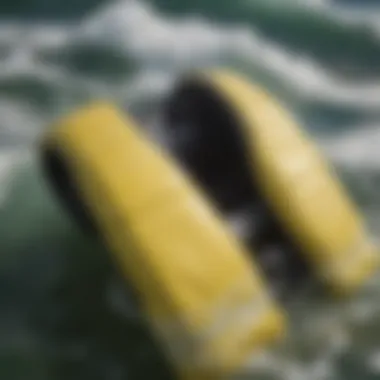
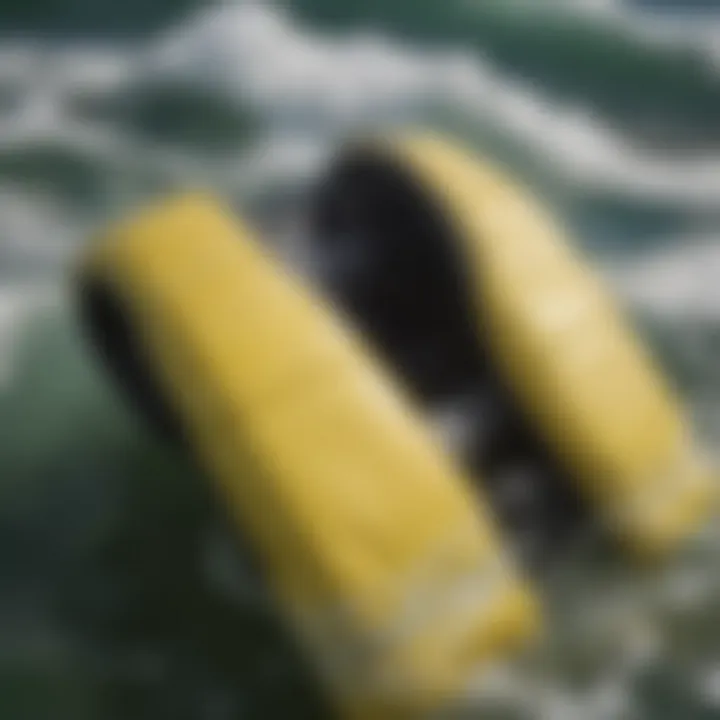
By following these simple steps, surfers can give their flotation vests a longer life, ensuring they are ready for the next adventure.
When to Replace Your Vest
Even the best water gear won't last forever, and knowing when to retire your flotation vest can be a matter of safety. Here are some indicators that it might be time to consider a replacement:
- Visual Damage: Check for visible signs of wear such as cracks, tears, or faded colors. If the material looks compromised, it’s a warning sign.
- Compression Loss: Over time, flotation materials can compress, reducing buoyancy. If you notice it feels less buoyant during use, consider replacing it.
- Age of the Vest: Generally, a good flotation vest should be replaced every 2 to 5 years depending on how often it is used and how well it has been maintained. Even vests that look good externally can lose their effectiveness internally.
- Regulatory Standards: Make sure your vest adheres to current safety standards. If it doesn't meet new regulations, it’s time for an upgrade.
“The safety of your day on the waves hinges on the reliability of your gear.”
By staying vigilant regarding the condition of your flotation vest, you not only enhance your personal safety but also ensure a better surfing experience.
User Experiences and Expert Opinions
When considering the importance of flotation vests in surfing, it's invaluable to gather insights from those who know the waters best: seasoned surfers and instructors. Their experiences shape not just their own practices but pave the way for newcomers to the sport. Understanding these perspectives offers a real-world lens on the navigational safety and performance enhancement these vests provide.
Testimonials from Seasoned Surfers
The voices of experienced surfers resonate with authenticity. Many tout flotation vests as essential gear, often sharing anecdotes that highlight their role in both safety and confidence on the water.
"I remember a time when I was caught in a very strong rip current. My flotation vest kept me buoyant even as I struggled against the waves. I really would not be here today without it," says Jamie, a surfer of over a decade.
Such personal stories underscore a core message: flotation vests can be lifesavers in unexpected situations. Surfers often discuss how these vests made them feel more secure while tackling challenging waves or participating in competitions. Here are some key points from seasoned surfers:
- Increased Confidence: Many surfers feel empowered knowing they have an extra layer of safety.
- Enhanced Endurance: With added buoyancy, they can focus on balance and technique rather than worrying about floundering.
- Personalization of Gear: Various brands and designs allow surfers to choose a vest that fits their style, providing a sense of individuality even in safety gear.
Insights from Surfing Instructors
Surfing instructors also provide critical insights, emphasizing the role of flotation vests not just for safety, but for teaching effective surf techniques. They often express that flotation vests instill a sense of security, allowing trainees to focus on the fundamentals.
Instructors like Lee, who has spent years teaching surfers of all ages, states, "For beginners, flotation vests are an absolute must. It’s a tool that allows students to learn how to read the waves while feeling safe. This safety net can be the difference between a positive experience and one that drives a beginner away from the water."
Factors highlighted by instructors include:
- Tailored Learning: The presence of flotation vests allows instructors to introduce maneuvers without the fear of injury.
- Encouragement in Learning: Students tend to push their limits due to the buoyancy, trying tricks or waves they may not have otherwise tackled.
- Long-Term Safety Practices: Instilling the habit of wearing flotation vests can cultivate a culture of safety among young surfers.
Combining these testimonials and insights presents an eclectic mosaic of thoughts on flotation vests, showcasing their paramount role in the surfing community. Whether you’re a seasoned pro or just starting your journey in the waves, listening to these voices can profoundly influence your perspective on incorporating this essential safety gear into your surfing arsenal.
The Future of Flotation Vests in Surf Culture
The realm of surfing is not just about riding the waves; it’s about being in sync with the ocean. This connection demands that the gear surfers choose, including flotation vests, stay ahead of the trends. As surfers look to enhance their safety and performance, the future of flotation vests becomes a focal point of discussion. This section will unravel the elements shaping flotation vests and their relevance in the surf community. If you think about it, the evolution of these vests is a reflection of both technology and culture.
Flotation vests are not merely tools for buoyancy. They are becoming increasingly integrated into the fabric of surfing life. The developments we're seeing now—ranging from advanced materials to specialized designs—are catering to the novice surfer all the way up to seasoned pros. Offering more than just safety, these vests are becoming a lifestyle choice, intertwining aesthetics with functionality.
"Flotation vests are no longer just about safety; they are part of the surfer's identity—it's about style, performance, and a commitment to sustainability."
Innovations on the Horizon
Innovation is the name of the game in surf gear. The future of flotation vests is bright, fueled by technological advancements that promise not just better safety, but also improved comfort and performance. Some exciting developments include:
- Smart Fabric Technology: Imagine a vest that adapts to water temperature or communicates with wearable devices. These advancements are on the way, helping surfers monitor their physical status while they ride.
- Lightweight Yet Sturdy Materials: Manufacturers are experimenting with various polyethylene foams and advanced mesh materials that provide better buoyancy without the burden of extra weight.
- Enhanced Mobility Designs: New designs are focusing on allowing greater freedom of movement, ensuring that surfers can paddle and maneuver without restriction, unlike the bulky vests of the past.
As these innovations unfold, one can almost envision the surf community embracing flotation vests as critical pieces of gear rather than mere safety accessories.
Trends in Surf Gear Development
Alongside technological advancements, various trends are influencing the design and adoption of flotation vests in surfing.
- Sustainability: More manufacturers are prioritizing eco-friendly materials in their product lines. There's a growing awareness of ocean health, and brands are stepping up with vests that minimize environmental impact through recycled materials.
- Customizable Options: The market is seeing a swell in bespoke options, allowing surfers to tailor their flotation vests according to personal style, color schemes, and fitting preferences.
- Integration with Other Gear: Future flotation vests might include functionality that allows them to be part of a comprehensive surfing system, such as incorporating hydration systems or attachable pockets for essentials.
In summary, the future of flotation vests intertwines myriad aspects like technology, environmental responsibility, and personal expression. By embracing these changes, the surfing community can look towards an era where safety, comfort, and style coalesce into a single, transformative experience on the waves.















